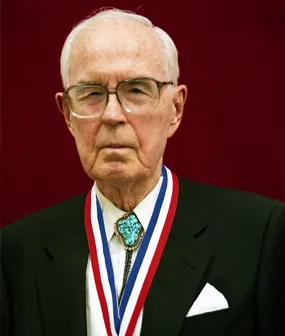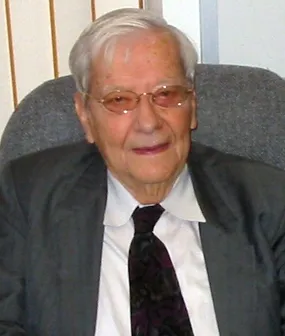The Calculating Nobel Laureates

Anyone who has ever been a part of the College of Optical Sciences has participated in a community of great thinkers and, consequently, witnessed a variety of great thinking styles. There are those scientists who prefer to toil alone in the laboratory and those who are best led to new ideas while brainstorming with others. Some pace the halls to stimulate thinking, while others must sit silent and still to organize their thoughts.

Then there are those who may appear to be asleep or meditating when, in reality, they are solving difficult problems in their minds. After chatting with professor Masud Mansuripur, I came away with the feeling that this style worked best for Nobel laureate and Professor Emeritus Willis E. Lamb Jr.
In the mid-1990s, Masud and Willis, along with another Nobel laureate, professor Nicolaas (Nico) Bloembergen, attended a dinner party at former OSC director Peter Franken’s house. Masud mentioned to the group that he had sat on a student’s oral prelim exam committee that day, and the conversation quickly turned into a lively discussion of questions that would test a student’s ability to solve problems.
Masud shared the “off-the-wall” scenario he had posed to gauge the student’s ability to “stay poised and think fast in an unscripted world.” (When relating the story to me, he explained that he was also trying to teach the student to deal with logic that is approximate, rather than fixed and precise.)
“Imagine you are hosting a party and inviting all the people of the world to attend. You are planning on everyone standing, with one square foot of floor space allotted per person. Approximately, what size of venue would be required to host such an event? And would that space be closer to the area of the United States or of Texas?”
Masud told everyone at the table that he had one or two students figure out the correct answers right away, but that most had struggled with two basic facts: the population of the world, which was approximately 6 billion in 1995, and how many feet are in a mile, which is exactly 5,280. In those cases, after a few painful moments for the student, Masud provided these key numbers that enabled most students to perform the calculations.

Immediately following this statement, Nico spoke up and said, “Interestingly enough, the size of the venue needed, at approximately 215 square miles, would be very close to the size of the city of Tucson which is around 15 by 15 square miles.”
Masud recalled everyone at the table was “very impressed with the speed and precision of Nico’s calculation.” Meanwhile, “Willis, sitting at the head of the table, seemed to be napping, perhaps bored with the conversation.”
Shortly afterwards, everyone began making their way toward the front door and saying their “goodnights.” As Peter was retrieving coats, Willis spoke to Masud: “I learned during dinner that you are Iranian. I once attended a conference in Tehran. The Hilton hotel where I was staying was hosting a wedding party and the place was so noisy I couldn’t sleep. I endured until around 2 a.m., then got out of bed, packed my things and found another hotel to check into somewhere else in the city. By the way, if you put all those people invited to your theoretical party in a box, you could drop them into the Grand Canyon!”
